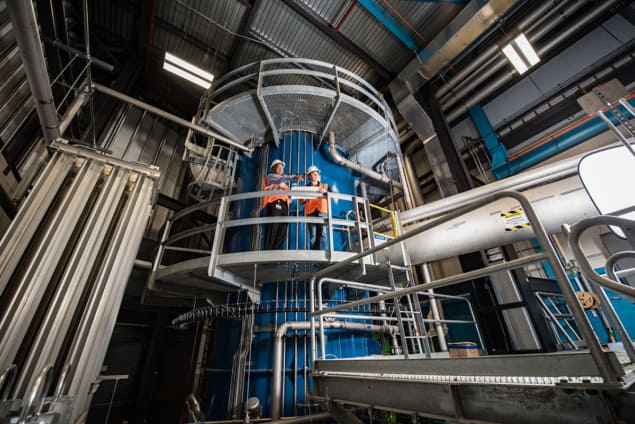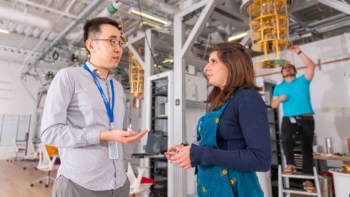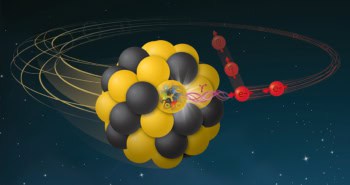Creating a new cutting-edge accelerator isn’t cheap or easy. But as Kit Chapman discovers, the upcoming Facility for Rare Isotope Beams (FRIB) in Michigan promises great things for nuclear physicists especially those with applications in mind

“We’re going to double the number of known isotopes,” says Artemis Spyrou, an experimental nuclear physicist at the National Superconducting Cyclotron Laboratory (NSCL) in the US. “It’s crazy. We know more than 3000 isotopes at the moment. And we going to double that.”
It’s a bold mission statement, akin to the greatest single expansion of our known chemical universe in history. But that’s the lofty goal that Spyrou and others like her hope to achieve when their next-generation particle accelerator – the $730m Facility for Rare Isotope Beams (FRIB) – comes online at Michigan State University in 2022.
FRIB is just one example of a “big-science” facility – a term coined in the 1930s by the US nuclear physicist Ernest Lawrence at the University of California, Berkeley. Rather than having his team members working independently, Lawrence pooled his fellow physicists, encouraging them to collaborate and specialize. It was a philosophy that allowed the lab to build ever-bigger and more complex machines, eventually leading to the discovery of the antiproton and antineutron, as well as the creation of 15 chemical elements, none of which exist in any appreciable quantities on Earth.
At the heart of Lawrence’s work was the cyclotron – a type of particle accelerator for which he was awarded the 1939 Nobel Prize for Physics. Particles enter in the centre of the device, before being spun out in a spiral with the aid of an electromagnet, passing through two semi-circular electrodes. By alternating the voltage across the electrodes, the particles get attracted and repelled in a push-and-pull effect that accelerates them until they eventually leave the machine, where they are used for experiments.
Big science, big thinking
Lawrence’s first cyclotron was a mere 10 cm in diameter and made from basic laboratory items. By 1932 he had designed a 69 cm machine and by 1939 his entire research team could sit on the housing of a 152 cm cyclotron, which would be used to discover the elements neptunium and plutonium. After the Second World War, even bigger machines – synchrotrons – were created from the cyclotron concept, in which particles are accelerated by being sent round and round a large, circular ring.
In the US, federal funding agencies don’t generally build infrastructure
David Morrissey, National Superconducting Cyclotron Laboratory
While the big-science spotlight might today be on particle physics – and especially the upgrade to CERN’s Large Hadron Collider – nuclear physics has plenty of big facilities too. The EU-funded Facility for Antiproton and Ion Research (FAIR) at Darmstadt in Germany, for example, is a heavy-ion research ring 1.1 km in circumference, which will (when it opens) have cost €1.3bn to build. Pushing the boundaries of science can no longer be done on a shoestring.
Indeed, new facilities are often so big and expensive that labs almost always have to enter partnerships with governments, with negotiations sometimes spanning decades before construction starts. In the case of FRIB, it was first conceived in the 2000s and has been more than a decade in the making, despite Michigan State University having had an accelerator facility on site since the 1960s. Funding comes from the US Department of Energy’s Office of Science (DOE-SC), the university and the Michigan state government.

Neutron dripline extended to fluorine and neon isotopes
“In the US, federal funding agencies don’t generally build infrastructure,” points out David Morrissey, a nuclear chemist at NSCL. “They prefer to build instruments and fund the science. So the university contributed the money for the infrastructure, and it is very good at buildings.” Now about 95% complete, FRIB was officially designated a DOE-SC scientific user facility in September 2020, with more than 1400 scientists from around the world poised to conduct research at the site.
But with such a high price tag – plus annual running costs of $100m – the scientists and engineers constructing FRIB have had to spend carefully. “We have to be absolutely clear how the money is spent to show it is used effectively and not just squandered in any way,” Morrissey says. “We’ve survived by being innovative and doing things that other people can’t.” And that means firing beams that don’t exist anywhere else on Earth.
Accelerating knowledge
Construction began in 2014, but experiments have continued throughout that time at NSCL’s two existing cyclotrons, which provide nuclear physicists with ion beams thanks to funding from the National Science Foundation. When I visited FRIB in 2019, I discovered a vast and impressive maze of metal stairwells and poured concrete, leading to giant machines humming with power.
Once FRIB comes online early in 2022, the two older machines will be decommissioned and the lab will switch to a superconducting linear accelerator, in which the radio-frequency modules that speed up particles are placed in a line, rather than a ring. “The difference will be a 1000-fold increase in beam intensity,” says Paul Mantica, FRIB’s project manager. “Currently we’re running about half a kilowatt of beam power on the target on average. When we run FRIB, it’ll be 400 kilowatts on the target.”
The linear accelerator will be able to create beams of essentially all known stable isotopes, with the isotopes having first been separated from mined substances either by weight or through chemistry before stripping them of electrons. Physicists can then fire trillions of ions of any particular type per second at targets of heavier nuclei. Usually, the ions will miss the nuclei. But if they hit, both the target nucleus and ion will break apart.

Amid the chaos of flying particles, two nuclei will very occasionally collide, fusing to form an unstable isotope. Nuclear physicists will isolate the isotope using a “separator” – essentially a sequence of magnets that can be configured so that everything else is deflected out of the way. The pure, unstable isotope can then be studied and characterized through spectroscopy.
The FRIB targets themselves are placed on a carbon wheel that will be spinning at 5000 revolutions a minute to prevent the beam’s intense heat from burning it. The beam will then pass through four sets of the most advanced separators in the world to remove the unwanted reaction products. Indeed, it’s the sum of these different parts – accelerator, separator and instruments – that makes FRIB stand out from the crowd.
Researchers at FRIB are planning to use the facility to carry out three different types of experiments. One will be to study beams that travel at half the speed of light, with the high energy overcoming the inherent repulsion between the ions and target nuclei, enabling (as mentioned above) new isotopes to be created. Another will be to stop the beam in a given gas, allowing scientists to “weigh” isotopes or do laser spectroscopy on them.
“The third area is taking those stopped beams and re-accelerating them, producing energies more appropriate for astrophysics reactions,” says Mantica. “You have a gas target, the beam will then hit that target, and simulate events that happen in novae, in stars.”
Underground, overground
With lots of researchers expected to use the facility, FRIB is designed to operate at more than 90% availability, running 24 hours a day, 365 days a year. The facility is also modular, allowing electromagnets, sensors or other parts to be removed and replaced quickly and remotely. In fact, as Mantica explains, “Our goal is not to access the accelerator unless we have to. As it’s superconductive, we have to keep it particle-free. Any vacuum connections we do are performed in a cleanroom.”
Most users won’t even see the machines responsible for their experiments, given that the 500 m accelerator is located more than 10 m underground. In fact, getting heavy ions to half the speed of light is an arduous process, requiring four different types of accelerating structures. A radio-frequency quadrupole structure will be used to accelerate the beam before it reaches the first section of the linear accelerator, which will use “quarter-wave” resonators. After passing through a “charge stripper”, which increases the charge state of the beam and increases the accelerator’s efficiency and reduces costs, the beam enters the second and third sections with “half-wave” resonators.
To oversee them all, the device has some 19,000 electrical cables, with around 360 amplifiers controlling the accelerating superconducting resonators. Operation requires radio waves at frequencies of 80.5 MHz and 322 MHz. In fact, the facility had to obtain a radio-station licence in case of radio-frequency leaks, although in the end that proved unnecessary as FRIB has been designed so well that no waves will ever get out.
We’ve built FRIB for 100% helium recovery. Any helium used goes into a purifier and gets recycled back into the system
Paul Mantica, FRIB project manager
The superconducting resonators are made of pure niobium, cooled in 46 different cryomodules filled with liquid helium to keep the accelerator a few degrees above absolute zero (which allows it to be superconducting). Given that helium is such a precious resource, the facility takes its stewardship of this vital material seriously, with the gas stored in seven, vast 110,000 litre tanks on the roof. “We’ve built FRIB for 100% helium recovery,” Mantica says. “Any helium used goes into a purifier and gets recycled back into the system.”
Indeed, almost everything at FRIB is designed to go unwasted. This includes the beam, the majority of which will travel through its target. “About 300 kilowatts go wholly unreacted,” Mantica adds. “So we have a beam dump, a drum of titanium filled with water.” The beam goes through the titanium, interacts with water and makes even more rare isotopes – longer-lived isotopes that the community is interested in that can be harvested.
The heart of stars
FRIB is certainly an impressive facility, but the real benefit will come from the experimental results it generates. For Spyrou, the opportunities are tantalizing. “When you go just a few steps away from nuclei we’ve measured already, you find surprises all the time,” she says. “We have seen nuclei where, instead of all the neutrons being packed together in the nucleus, they are in a halo: one or more neutrons flying far away from the central nucleus. These are the kinds of things you discover far from stability.”
When you go just a few steps away from nuclei we’ve measured already, you find surprises all the time
Artemis Spyrou, National Superconducting Cyclotron Laboratory
These halo nuclei make the radius of the nucleus far larger than would be predicted by simple nuclear models, although they are relatively short-lived, with half-lives measured in milliseconds. “Lithium-11 [which has four more neutrons than its most common isotope] has the size equivalent of a lead nucleus,” Spyrou says. “There are really basic properties of nuclei that we would never discover if we didn’t have facilities like here, and who knows what we’re going to discover.”

Typically, all known isotopes are represented on the chart of nuclides: a plot with the number of neutrons as its x axis, protons as its y axis (figure 1). All the known, stable isotopes form a long, snaking diagonal line: any isotope above the line has too few neutrons to be stable (it’s “proton rich”), while any isotope below the line has too many to be stable (it’s “neutron rich”). Many of the expected proton-rich isotopes have been discovered, but the area of potential neutron-rich nuclides has barely been scratched.
“Physics is just crawling in a limited area [of the chart],” says Witold Nazarewicz, FRIB’s chief scientist. “And that’s the role of FRIB. We’re going to probe reaction mechanisms experimentally. With rare isotope beams, we can probe more neutron-rich nuclei, which can then guide future experiments.”
As an astrophysicist, Spyrou is especially interested in the opportunity to explore the nuclear processes in the heart of stars – something so complex that not even the world’s most advanced supercomputers can model with any real accuracy. “We’ll finally be able to make the nuclei that are actually there, in a star, right now!” she enthuses. Her particular interest is in collisions, particularly the “r process” – a set of nuclear reactions that are responsible for about half of all nuclei heavier than iron.
The r process involves heavy seed nuclei capturing neutrons so fast that the nuclei don’t have time to radioactively decay. “It’s kind of a big mess, because neutron captures are tricky – even experimentally we can’t measure that, so there are entire areas we don’t know anything about,” Spyrou says. “But here [at FRIB] we can measure all the properties of those nuclei, and then extrapolate and say ‘OK, the process probably looks like this based on what we know today.’ How heavy is each nucleus? How long does it live for? We’ll actually be able to measure this and put it into a model that describes a neutron-star collision.”
Given the thousands of possible isotopes produced – and the multitude of possible reactions that could produce them – this means experimentalists and theorists at the facility have to operate hand in hand. “I work closely with a modeller,” Spyrou says. “And they’ll say that, out of the 10,000 reactions that are happening in a neutron-star merger, these 20 are the most important ones. As an experimentalist, I’ll then go and see what a facility like this can provide: what can my equipment measure?”

If the new measurements agree with theoretical predictions, it confirms that the researchers’ models work well. But if experiment and theory don’t tally, then both experimentalists and theorists have to figure out where the differences are coming from. “This is how new physics is discovered,” Spyrou says.
Those not involved in nuclear physics might well wonder if these rare isotopes – and the potential uncertainties of models that can only be seen through countless experiments – are really worth building a billion-dollar facility to study, especially when finite resources could be spent on applied technologies. For the FRIB team, however, real-world applications – for example, in medicine, energy, security and materials – are an important part of its research programme.
Indeed, Morrissey argues that big-science facilities are a good investment, citing the use of fluorine-18 in medicine. An isotope of fluorine with one neutron less than the element’s stable form (fluorine-19), it decays to create positrons, which can annihilate electrons to create light. Fluorine-18 has proved vital in positron emission tomography (PET) scanners, but its development relied on someone figuring out how to make fluorine-18 as a nuclear-physics target that they could then do chemistry on. “You don’t know before you start the experiment if someone will have a need [for what we create],” Morrissey says.
Spyrou agrees that nuclear physics is worth spending money on. “In 1944 scientists discovered americium-241,” she says. “Then someone else came along and realized you could use it to make a smoke detector. And when technetium-99m was discovered in 1938, they didn’t realize it was going to be used for medicine; now every hospital has it.” The same will be true for FRIB, she believes. “I don’t know how FRIB’s discoveries will be important. But I do know they will be.”



